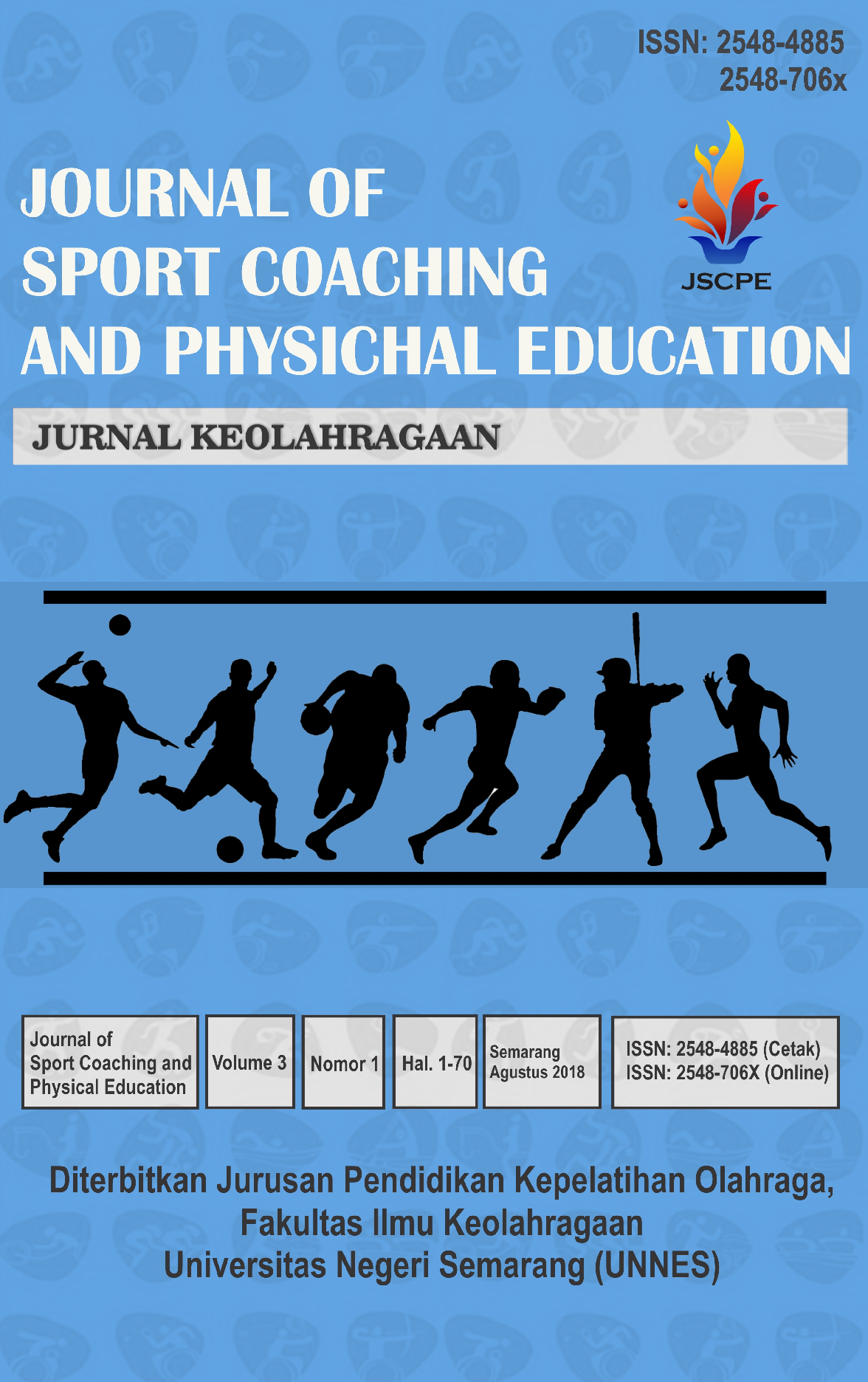PERBEDAAN ANTARA PENGARUH INSTRUKSI LANGSUNG DAN PENGAJARAN UNTUK MEMAHAMI PENDEKATAN HASIL BOLABASKET YANG DITINJAU DARI MINAT SISWA
##plugins.themes.academic_pro.article.main##
Abstract
The aim of this study is to know: (1) the difference between effect of DI and TGfU. (2) The difference in the playing basketball result among students interest. (3) The effect of interaction between learning approaches and interest in basketball outcomes. Data collection used playing basketball with a test of basketball. Data retrieval is conducted with GPAI. Data collection of students’ interest used questionnaires. The data analysis technique in this study used two-way variance analysis and Newman Keuls range test, at 5% significance level. The conclusion: (1) There is a significant difference between effect of DI and TGfU. (2) There is a significant difference in basketball outcomes between students interest. (3) There is a significant interaction effect between learning approach and interest in basketball game.
##plugins.themes.academic_pro.article.details##
References
Arends, R.I.. 2001. Exploring Teaching: An Introduction to Education. New. York: Mc Graw-Hill Companies.
Butler, J. & Griffin, L. 2010. More teaching games for understanding: Theory, Research and Practice. Champaign, IL: Human Kinetics.
Butler, J., Griffin, L., Lombardo, B., & Nastasi, R. 2003. Teaching games for understanding in physical education and sport. NAPSE.
Danny Kosasih (2008). Fundamental Basketball A First Step To Win. Semarang: CV. Elwas Offset.
David Bunker dan Rod Thorpe. 1982. Rethinking Games Teaching. Loughborough, Leicestershire: Dept. Of Physical Education and Sports Science. Unyversity of Technology.
FIBA Central Board. 2008. Official Basketball Rules 2014. Barcelona: FIBA
Forrest, Webb dan Pearson. 2008. An Integrated Approach To Teaching Games for Undertsanding (TGfU). http://ro.uow.edu.au/edupapers/52 diakses hari Sabtu 9 Mei 2015 pukul 13.45 WIB.
Griffin, Linda L., Mitchell, Stephen A., Oslin, Judith L. 1997. Teaching Sport Concepts and Skill. United States of America: Human Kinetics
Holt, N. L., Strean, W. B., & GarcÃa Bengoechea, E. 2002. Expanding the teaching games for understanding model: New avenues for research and practice. Journal of Teaching in Physical Education. 21, 162-176. Journal of Teaching in Physical Education, 21, 162-176.
Huitt, W., Monetti, D., & Hummel, J. 2009. Designing direct instruction. Pre-publication version of chapter published in C. Reigeluth and A. Carr-Chellman, Instructional-design theories and models: Volume III, Building a common knowledgebase (73-97).
Jewett, A.E., & Bain, L.L. 1985. The Curriculum process in the Physical Education. Dubuque, IA: Wm. C. Brown.
Memmert, Daniel dan Harvey, Steve. 2008. The Game Performance Assessment Instrument (GPAI): Some Concerns and Solutions for Further Development. Human Kinetics: Journal of Teaching in Physical Education, 2008, 27, 220-240.
Mitchell, Stephen A., Oslin, Judith L., Griffin, Linda L.2003. Teaching Sport Concepts and Skills: A Tactical Games Approachâ€. Illinois, Human Kinetics.
Pearson, P., Webb, P. 2008. “An Integrated Approach to Teaching Games for Understanding (TGfU)â€.
Robert E. Slavin. 2003. Educational psychology : theory and practice - 7th ed. Boston: Allyn and Bacon.
Saryono & Soni Nopembri. 2009. Gagasan dan Konsep Dasar Teaching Games for Understanding. Jurnal Pendidikan Jasmani Indonesia. Hlm.87-95
Slameto. 2010. Belajar dan Faktor-Faktor yang Mempengaruhinya. Jakarta: Rineka Cipta
Yelon & Weinstein. 1997. A Teacher's World: Psycology in The Classroom. Tokyo: McGraw-Hill Kogakusha Lt
